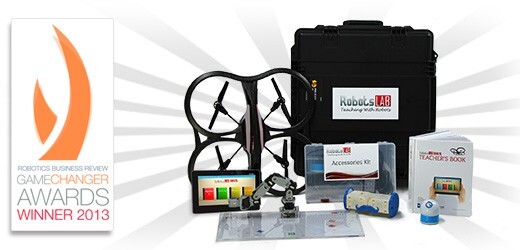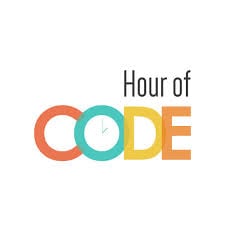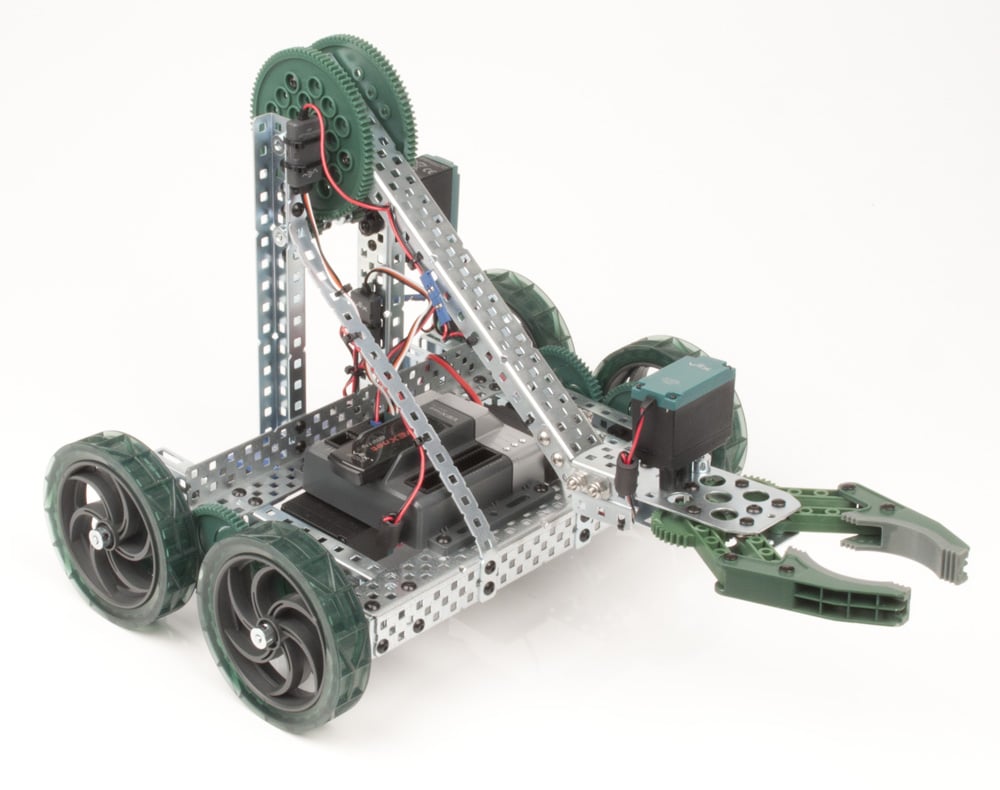RobotLAB Blog
Everything You Need To Know About Robotics in Businesses
Makerbot 3d printing in schools
Math teachers, science teachers and engineering teachers, are you looking for a way to make your beloved disciplines more relevant to your students? Maybe even inspire a few to love them the way you do? Well, right now there is affordable new technology out there that can help you do just that! The Makerbot 3D printer and STEM BOT 3D CLASS from our own RobotsLAB.
StemBot 3D program that teaches students how to 3D print a robot, assemble it, work on the electronics, and finally program it.
Actually, 3D printers have been around since the 1980’s, but they were massive and super-expensive like the first-generation computers. Only in the last few years have they shrunk in size and dropped in price to where individual households and schools could afford them.
- 0 Comments
- Apr 22, 2014 12:30:00 PM
Taking Math Out of the Classroom into the Construction Site
High schoolers building homes for the non-profit organization Habitat For Humanity is another great example of 21st Century math teachers taking math out of the classroom where it has been languishing for centuries and putting it to work in a fashion guaranteed to engage young minds and hands. Forty-nine High School students in Vancouver built homes while participating in a class called Math in Construction.
What did they learn? Well, confidence for one thing. An appreciation for real-world math for another."It was an amazing experience," said One young scholar. "I'm going to use this in real life."
- 2 Comments
- Mar 20, 2014 11:00:00 AM
- Posted by Charles Nimrad
- Topics: Math, Local News, Education, Student Engagement
Oklahoma public schools are boosting their STEM learning with RobotsLAB BOX
Oklahoma public schools are about to receive an enormous boost to their STEM learning programs. The innovative Oklahoma City STEM learning facility techJoynT has teamed with us here at RobotsLAB in San Francisco to bring our award winning RobotsLAB BOX with its innovative math teaching aids to public school students in the state. Yes, the study of math is about to become exciting!
As those of you familiar with this blog are aware, our BOX is designed to assist math educators in teaching abstract math concepts by engaging students with robots. And as Dr Peter Stone, Alfred P. Sloan Research Fellow, Guggenheim Fellow, AAAI Fellow, Fulbright Scholar, and Professor in the Department of Computer Science at the University of Texas at Austin, explains “You don’t need to be experienced with robotics or have a degree in computer science, just an enthusiasm for your subject area...You can open the BOX, turn on the preloaded tablet and within minutes be explaining quadratic equations with a quad copter.” This beats pontificating in front of a blackboard every time!
- 0 Comments
- Jan 31, 2014 6:02:00 PM
- Posted by Charles Nimrad
- Topics: Math, About the BOX, Local News, EdTech, STEM, Education, 21st Century Classroom, School, Student Engagement
Insider's summary of the hour of code initiative
This email sent by Gary Page from California Education Department is a great wrap up from the 'coding week' which was a huge success!

"
Teacher/Administrator:
Special thanks to all the teachers and administrators who took time to introduce students to coding during the recent Hour of Code week. The campaign brought attention to the need for all students to understand computational thinking and will help bring attention to education policy and decision makers on the need to make computer science “count” towards graduation.
In a single week, students at schools across the U.S. wrote 500,000,000 lines of code as part of Computer Science Education Week, organizers said.
- 0 Comments
- Jan 17, 2014 3:30:00 PM
- Posted by Charles Nimrad
- Topics: STEM, National News, Education, Computer Science, code, School, Student Engagement
Students smart shop with calculators
One of a number of interesting educational initiatives nationwide by and for kids is the Kids Feeding Kids Program undertaken by 26 Students from the Dobson and Copeland elementary schools’ Academically and Intellectually Gifted (AIG) program in Dobson NC. Dobson NC, by the way, is near legendary (mythical?) Mt Airy, NC, home of the Andy Griffith Museum. This is Mayberry R.F.D. country!
And in the best traditions of Mayberry R.F.D.’s good neighbors, the elementary students in the program are urged to study about the underprivileged and the just plain unlucky and then work up a plan to feed the kids found in these situations. Their teachers hope this study will inspire their sense of social responsibility as well as giving them a background in the real-world art of smart grocery shopping.

- 0 Comments
- Jan 16, 2014 6:00:00 AM
- Posted by Charles Nimrad
- Topics: Local News, Education, School, Student Engagement
Robotics competition draws students from all over Texas
It makes me proud as an expatriate Texan to find that the state of Texas is one of those states that realizes STEM learning is important and is doing something to ensure that its students meet the educational requirements of the new millennium in science, technology, engineering and math.
The Vex competition at Roosevelt high school in San Antonio is a good example.
One of the teams in the event sponsored by the U.S Army was a Vex team from an all-girls robotics club at the school.
So seriously does the state of Texas view these competition that recently the Texas Workforce Commission funded a startup grant to help 400 new Vex robotics teams in Texas.
Sounds like a lot of teams, does it?
Well countrywide 9000 Vex robotics teams are expected to compete in the USA this year.
Texas intends to have its share.
If you find yourself wondering what a Vex robotics team is, the VEX Robotics Design System is centered around the VEX Clawbot Kit.
The Clawbot is similar to the LEGO NXT in that assembly and disassembly is made simple with assorted pieces easily fitted together.
Some say that the Clawbot is cheaper.

- 0 Comments
- Jan 15, 2014 10:30:00 AM
- Posted by Charles Nimrad
- Topics: Robotics, Local News, STEM, Education, Computer Science, School, Student Engagement, Middle School
Here’s why we absolutely need EdTech
Here’s a question for you: What is your opinion as to the importance of EdTech in education? EdTech, as you know, is short for educational technology.
What defines EdTech, you ask?
Good question! You see the term everywhere but no definitions. So let’s go with the definition advanced by our good friends at Wikipedia: "Educational technology, sometimes termed EdTech, is the study and ethical practice of facilitating e-learning, which is the learning and improving performance by creating, using and managing appropriate technological processes and resources…" "Appropriate technological processes and resources" include more than just the Internet, although online courses are important tools; tablets, computers, cell phones, the whole digital zoo is included. Even robots! Especially robots!

- 0 Comments
- Dec 30, 2013 4:30:00 PM
- Posted by Charles Nimrad
- Topics: EdTech, STEM, Education, 21st Century Classroom, School, Student Engagement, Middle School
To learn algebra secret way to student hearts
It's not a big secret, committed teachers have been aware of this forever. The best way to get students to learn anything about a subject is to find out what they are interested in and then show them how what interests them relates to the subject the teacher hopes to teach them. But like most things we believe instinctively it is always nice to find scientific proof for our beliefs.
Recently researchers using a Carnegie Learning software called cognitive tutor put high school students in two distinct groups to study Algebra. In one group were the students whose backgrounds had been researched in order to discover their personal interests. Stuff like music, movies and sports. These students received their algebra with lesson plans attuned to their personal interests. The second group was taught in the good old way math has always been taught, from a book and with no attention paid to the kids real lives. Can you guess what those researchers discovered? Exactly!
- 0 Comments
- Dec 23, 2013 12:53:58 PM
- Posted by Charles Nimrad
- Topics: Math, National News, Education, Student Engagement, algebra,
What Is Wrong With American Education?
As with everything else the question is best answered by "it depends!" In this case it depends on who you ask.

Ask many reformers and they’ll assure you there is plenty wrong as shown by the poor showing American students make on international standardized tests. We can not completely ignore that.
But ask Scot Osterweil, a professor at the MIT Media Lab, and he will tell you that he believes educators need to worry less about standardized tests and work harder toward inspiring students' natural creativity.
- 0 Comments
- Nov 18, 2013 12:21:00 PM
- Posted by Charles Nimrad
- Topics: STEM, Education, Student Engagement
Business and education leaders urge STEM education, What about you?
It’s pretty much the same everywhere. There are simply too few skilled workers to go around. This is particularly true in the trades and industries depending on skilled workers with a background in science, technology, engineering and math. (STEM)
Provo, Utah is a good example of a technology center that should have no problem recruiting workers. Nestled in the beautiful Utah Valley surrounded by the snow-capped Wasatch Mountains and home to Brigham Young University, it still find itself forced to depend on immigrants to meet the needs of local technology companies. Provo's mayor, John Curtis says "My single biggest impediment to bringing businesses to Provo is that there are not enough qualified workers."
- 0 Comments
- Nov 1, 2013 9:30:00 AM
- Posted by Charles Nimrad
- Topics: STEM, Education Politics
Relevant Posts
- Augmented Reality: A Tool for Teaching Students Robot Programming
- Fostering Innovation Through Youth Education in STEM and EdTech
- How Parents Can Foster STEM Learning Beyond the Classroom
- How Robotics Cultivates a Deep Understanding of Mathematics in Students
- RobotLAB Receives EDTech Chronicle 2023 ‘BESTIE’ Award for Landmark Partnership with American Samoa Dept. of Education.
Subscribe to Email Updates
-
I Want To Learn MoreADDITIONAL INFORMATION

